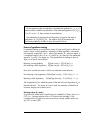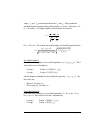
Page 18-38
The criteria to use for hypothesis testing is:
Θ Reject H
o
if P-value < α
Θ Do not reject H
o
if P-value > α.
The P-value for a two-sided test can be calculated using the probability functions
in the calculator as follows:
Θ If using z, P-value = 2⋅UTPN(0,1,|z
o
|)
Θ If using t, P-value = 2⋅UTPT(ν,|t
o
|)
Example 1
-- Test the null hypothesis H
o
: μ = 22.5 ( = μ
o
), against the
alternative hypothesis, H
1
: μ ≠22.5, at a level of confidence of 95% i.e., α =
0.05, using a sample of size n = 25 with a mean ⎯x = 22.0 and a standard
deviation s = 3.5. We assume that we don't know the value of the population
standard deviation, therefore, we calculate a t statistic as follows:
The corresponding P-value, for n = 25 - 1 = 24 degrees of freedom is
P-value = 2⋅UTPT(24,-0.7142) = 2⋅0.7590 = 1.518,
since 1.518 > 0.05, i.e., P-value > α, we cannot reject the null hypothesis H
o
: μ
= 22.0.
One-sided hypothesis
The problem consists in testing the null hypothesis H
o
: μ = μ
o
, against the
alternative hypothesis, H
1
: μ > μ
ο
or H
1
: μ < μ
ο
at a level of confidence (1-
α)100%, or significance level α, using a sample of size n with a mean ⎯x and a
standard deviation s. This test is referred to as a one-sided or one-tailed test.
The procedure for performing a one-side test starts as in the two-tailed test by
calculating the appropriate statistic for the test (t
o
or z
o
) as indicated above.
7142.0
25/5.3
5.220.22
/
−=
−
=
−
=
ns
x
t
o
o
μ


















